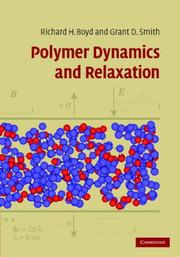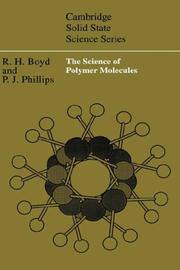| Listing 1 - 4 of 4 |
Sort by
|

ISBN: 9780521152914 9780521814195 0521814197 9780511600319 9781107321489 1107321484 0511600313 9781107316096 110731609X 1107194997 9781107194991 1139809792 9781139809795 1107317053 9781107317055 1107317959 9781107317956 1299399258 9781299399259 1107315115 9781107315112 0511888872 9780511888878 0521152917 Year: 2007 Publisher: Cambridge Cambridge University Press
Abstract | Keywords | Export | Availability | Bookmark
 Loading...
Loading...Choose an application
- Reference Manager
- EndNote
- RefWorks (Direct export to RefWorks)
Polymers exhibit a range of physical characteristics, from rubber-like elasticity to the glassy state. These particular properties are controlled at the molecular level by the mobility of the structural constituents. Remarkable changes in mobility can be witnessed with temperature, over narrow, well defined regions, termed relaxation processes. This is an important, unique phenomenon controlling polymer transition behaviour and is described here at an introductory level. The important types of relaxation processes from amorphous to crystalline polymers and polymeric miscible blends are covered, in conjunction with the broad spectrum of experimental methods used to study them. In-depth discussion of molecular level interpretation, including atomistic level computer simulations and applications to molecular mechanism elucidation, are discussed. The result is a self-contained approach to polymeric interpretation suitable for researchers in materials science, physics and chemistry interested in the relaxation processes of polymeric systems.
Polymers --- Molecular dynamics --- Polymères --- Dynamique moléculaire --- Structure --- Polymères --- Dynamique moléculaire --- Polymers. --- Molecular dynamics. --- Dynamics, Molecular --- Dynamics --- Polymere --- Polymeride --- Polymers and polymerization --- Macromolecules --- Structure. --- Polymers - Structure

ISBN: 0521320763 Year: 1993 Publisher: Cambridge Cambridge University press
Abstract | Keywords | Export | Availability | Bookmark
 Loading...
Loading...Choose an application
- Reference Manager
- EndNote
- RefWorks (Direct export to RefWorks)
Book
ISBN: 0511600321 Year: 1993 Publisher: Cambridge : Cambridge University Press,
Abstract | Keywords | Export | Availability | Bookmark
 Loading...
Loading...Choose an application
- Reference Manager
- EndNote
- RefWorks (Direct export to RefWorks)
This book is an introduction to polymers and focuses on the synthesis, structure and properties of the individual molecules that constitute polymeric materials. It approaches polymeric materials from a molecular basis on the belief that there is a common core of knowledge and principles concerning polymer molecules that can be set out in an introductory work. Subjects treated include an introductory overview of synthesis, an introduction of the concept and definition of molecular weight and its distribution, experimental methods for measuring molecular weight, a more detailed view of polymerization including kinetics and mechanism, and the three-dimensional architecture of polymers as determined by conformation and stereochemistry. The statistical description of the conformational disorder of the molecules is covered and then built upon in treating rubber elasticity and polymer solutions.

ISBN: 9780511600326 9780521320764 9780521565080 Year: 1993 Publisher: Cambridge Cambridge University Press
Abstract | Keywords | Export | Availability | Bookmark
 Loading...
Loading...Choose an application
- Reference Manager
- EndNote
- RefWorks (Direct export to RefWorks)
| Listing 1 - 4 of 4 |
Sort by
|

 Search
Search Feedback
Feedback About UniCat
About UniCat  Help
Help News
News